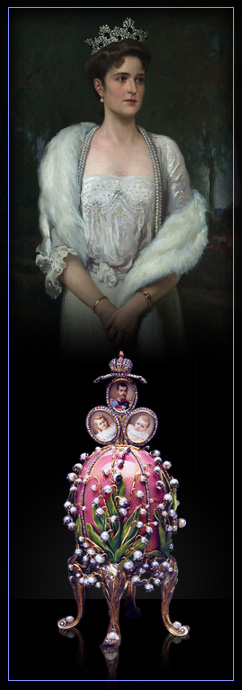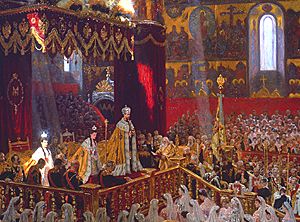Olson Defendorf Custom Homes wins prestigious design award from Houzz.


 Chapter VIIThe Coronation, 1896 Above: Coronation of Nicholas and Alexandra in Uspensky Sobor. Painting by L. Tuxen from the Anichkov Palace, now in the Hermitage. At the Coronation the whole old-world pomp of the Russian Court was displayed. It was a glorious pageant for the whole country, apart from the importance it had in the eyes of those who saw in the religious rites the real consecration of their sovereign. Everything was done to foster this feeling in the people who came to Moscow for the celebrations from every part of the vast Russian Empire. The Emperor granted amnesties to prisoners, and bounties to all classes of his subjects: fines were remitted, and facilities given for payment of taxes. During the days before the actual Coronation, the Emperor and Empress were at the Petrovsky Palace near Moscow, preparing themselves by retreat and fasting for the ceremony. Princes representing nearly every sovereign in Europe came to Moscow, though no reigning sovereigns were present (except Queen Olga of Greece, as a Russian Grand Duchess), for on this occasion the Emperor and Empress had to play the chief role, and could give precedence to no one. All the Embassies had migrated to the old capital, and were lodged in different palaces, belonging to the great families there. On the day of the Coronation the state entrance to the Kremlin was a marvellous sight. Tremendous crowds lined the streets and every class of person was represented. Side by side with well-dressed ladies were peasants in Sunday clothes, and the enthusiasm of all was indescribable, all crossing themselves in emotion as the procession passed. The Emperor rode alone at the head of the procession, surrounded by all the Grand Dukes and foreign Princes. The Empresses followed in the beautiful gilt state coaches, real eighteenth-century works of art, the, panels painted by Boucher. The Dowager-Empress went first; and as she had already been crowned, her coach was surmounted by a crown. The Empress Alexandra Feodorovna drove alone, and had no crown on her coach. The long progress through the city lasted for several hours. When it reached the Iverskaya gates, all dismounted, the Empresses leaving their coaches to enter the Chapel of Our Lady, which contained the celebrated Iverskaya, a greatly venerated ikon, before which everyone passing bared his head. The procession entered the Kremlin through the Nicholsky gates, and then vanished from the sight of the people, who stood gazing spellbound after it, as if hoping that the brilliant vision would appear again. The next day, heralds in mediaeval dress read out the proclamation announcing to "the good people of Our first capital" that the coronation was fixed for the 26th of May and was to be held in the old Cathedral of the Assumption, "Uspensky Sobor." This was a fitting setting for so impressive a ceremony. Though the cathedral had suffered much at the time of the French invasion in 1812, when Napoleon's troops had stabled their horses there, its ancient splendor had long since been restored. All its walls and pillars were covered with fifteenth-century frescoes, depicting the Saints and scenes from the Old and New Testaments. This brilliant background enhanced the beauty of the uniforms and robes. The jewels worn were wonderful, the Grand Duchess Serge's famous emeralds and the old Grand Duchess Constantine's sapphires, every flawless stone of which was about two inches across, attracted the attention of all. The ikonostasis (altar screen) glittered with gold and silver, and in it were enshrined some very old and venerated ikons. The ceremony began early in the morning and lasted for several hours. The Emperor and Empress came on foot to the Cathedral in a state procession from the Kremlin. First came the Dowager-Empress alone, pale and serious-looking, with sad eyes, that reminded the onlookers that her own coronation had been not many years before. After her, each walking under a separate canopy, came Nicholas II and the Empress Alexandra Feodorovna, attended by numerous court officials in splendid uniforms. In contrast to the Dowager-Empress, who was blazing with diamonds and wearing an Imperial crown, the young Empress had no jewels except a string of pearls round her neck. She wore a Russian court dress of silver tissue, her hair in two long "love-locks," and no ornaments on her head where the Imperial crown was to rest. She looked lovely. At first she was a little flushed and nervous, but regained her self-possesion as the ceremony proceeded. The Emperor wore the uniform of the Preobrajensky regiment, the oldest regiment in Russia. He had at first expressed the wish to wear the robes of the old Tsars and their old "Monomach" crown, as the newer "Imperial" crown was very heavy (9 lb.) and he had suffered from acute headaches ever since he had been wounded in the head by a Japanese fanatic at Otsu. Iron etiquette proclaimed the change impossible, and the Emperor was condemned to suffer considerable pain from the heavy crown. The whole long five-hours ceremony was a time of intense emotion to the Empress Alexandra. She was not tired at all, she told her sisters, everything was so beautiful. It seemed to her to be a kind of mystic marriage to Russia. She became one with Russia, sealed for ever a Russian in heart and soul, and so she remained from that day and all her life. The long Mass, the robing of the Emperor, his investiture with the Imperial insignia, she saw as in a dream. It is easy to imagine how ardent were her prayers as she knelt with every other person, while the Metropolitan read he prayer for the Emperor, and how her heart went out to his when he knelt, this time all alone, the others standing, and prayed for Russia and his people. Then Their Majesties alone received the Holy Communion, and the Metropolitan anointed the Emperor with the holy oils. On this one day, the only time in his life, the Russian Emperor enters the sanctuary and receives the Blessed Sacrament like a priest. When Nicholas II went up the altar steps the chain of the order of St. Andrew fell to the ground - a bad omen to superstitious eyes. But the Empress was not troubled by this. She only saw the sunbeam that fell at that moment on his head, and felt it to be a kind of halo. The Emperor crowned himself, the Metropolitan handing him the crown. Then the Empress left her place and knelt before him. The Emperor took off his crown and touched her forehead with it. Then he took a smaller crown and with the utmost gentleness put it on her head. Her ladies fixed it on. The Emperor kissed her, took her hand as she rose, and both went to their places on their thrones. The church ceremony ended with the Empress Marie and all the Princes present doing homage to their crowned and anointed ruler. When his mother approached, pale with emotion, the Emperor's embrace seemed to everyone to be, not that of sovereign to subject, but of a dutiful son to his mother. The whole procession left the Cathedral on foot and returned to the Kremlin. This time the Emperor and Empress Alexandra Feodorovna headed it in full regalia. Bells rang in all the "40 times 40" Moscow churches, cannon thundered, and the countless multitudes in the streets shouted themselves hoarse. The Imperial couple turned at the top of the celebrated Red Staircase, and bowed low to the crowd three times. This symbolized their greeting to the country. In the palace they passed the representatives of their Mohammedan subjects, whose religion did not allow them to enter a Christian church. h. These were, certainly, the most picturesque of all the guests; the splendor of their dress alone would take pages to describe. In a room by themselves stood a group of people in ordinary clothes. The foreign Princes inquired who these were, and were told that they were all descendants of people who had saved the lives of Russian sovereigns at different times. There were descendants of Ivan Sussanin, who had, by sacrificing his own life, saved the first Romanov from the hands of the Poles, others who had saved Alexander II from assassination. Their presence spoke of the constancy of Imperial gratitude, but was a suggestive reminder. The coronation banquet took place on the same day. Its scene was the old Granovitaya Palata, the Council chamber of former Tsars. The walls were painted in frescoes, like those of the Cathedral of the Assumption. A special table was set for the Emperor and Empress, under a baldachin. There they dined alone, wearing, their robes and crowns. High court officials waited upon them. The head carver handed the dishes, the "grand échanson " the goblet. The foreign ambassadors came in, and with each the Emperor drank a separate health. The foreign Princes watched the scene from the windows of the upper gallery (Tainik), from which the old Tsaritsas used to look down unseen at banquets and receptions, for only Russians took part in the banquet in the hall. In the evening illuminations made Moscow like a town in a fairy tale. The young Empress started the illuminations from the Kremlin by pressing a button hidden in a bouquet of roses. She "looked blooming and radiant," wrote her sister Princess Louis to Queen Victoria, in a long account of the proceedings. The Empress's brother and sisters were present, the Grand Duchess Serge looking especially magnificent in a Court dress of cream velvet embroidered with gold fuchsias; the Duke of Connaught came with the Duchess to represent the Queen of England. An attraction for all eyes were the beautiful Crown Princess of Rumania and her sister, the Grand Duchess Victoria Melita of Hesse, in dresses of cloth of gold, the one embroidered with autumn leaves, the other with violet irises. The immense bearded Emir of Bokhara in Oriental robes, wearing a Russian General's epaulettes in diamonds on his Oriental khalat, shared the admiration of the crowds in the streets with the Emperor of China's envoy, the celebrated Li-Hung-Chang, an unforgettable picture in his yellow mandarin's robes and peacock feather. The Empress, as a recent bride, took particular interest in an engagement that came about at the Coronation. The Prince of Naples (the present King of Italy), who represented Italy at the festivities, met the Princess Helena of Montenegro and became privately engaged to her at the house of the Grand Duchess Serge. No incidents marred any of the first day's proceedings. It had been planned that great fétes were to follow the religious ceremony, but only one ball at the Kremlin and one gala performance at the opera had been given before a terrible accident happened that cast a deep shadow over everything. By many it was considered ominous, and was compared to the disaster which marred the wedding ceremonies of King Louis XVI of France. A popular féte had been arranged at the Khodynskoe Pole outside the town, and in the course of it small gifts and souvenirs were to be distributed to the people. Peasants from all parts of the Empire had come to Moscow for this. The authorities had counted upon the same numbers as had attended the last coronation, but in reality the numbers were vastly greater. Owing to mismanagement by the local authorities, who had not taken the necessary measures to prevent a crush, the féte ended in disaster. It was a crowd "as large as that of three Derby days," writes Sir Francis Grenfell in his letters. The crowd tried to get to the booths where the presents were to be given, early in the morning, before the police had arrived or anyone was present to keep order, and a panic ensued. The whole surging mass of people collided. Thousands were killed and injured hours before the time when the féte was supposed to begin. The extent of the disaster only gradually became evident. At first no one could tell even approximately how many people had suffered. The whole truth was indeed not told to the Emperor at all. He was informed that an accident had happened, but not its full extent. There were still thousands of people who had travelled immense distances to see their Sovereign, perhaps for the only time in their lives. The Ministers thought that the countermanding of the entertainment would cause disappointment to the people who had not seen the accident ; and in consequence the Emperor and all his guests attended the féte at the appointed time in the afternoon. The Emperor's horror knew no bounds when he heard later of the terrible disaster that had preceded it. Both he and the Empress wanted to cancel the French Ambassador's ball, arranged for that very night. They were told this was impossible, the French Government having made the most extravagant preparations for the ball. Beautiful tapestries and plate had been sent expressly and at great expense from the Garde-Meuble National in Paris. The Emperor had to give in and go. The Empress had to control her tears, but it was with a face of utter misery that she attended the Marquis de Montebello's wonderful entertainment. She behaved like an automaton, and all her thoughts were with the dead and dying. When the Imperial couple visited the hospitals where the victims lay, the scenes which they saw rent the Empress's heart. She would have given up all festivities on the spot and have nursed the people with her own hands, but official duties had to be fulfilled. Private feelings were held of no account. The Emperor had large sums distributed to the relatives of the victims, but the sovereigns themselves had to go on with their parts, whatever it might cost them. The Empress never forgot her feelings at a State luncheon given just after their return from a hospital, at which she had surreptitiously to wipe her eyes with her napkin, as she remembered the terrible things she had seen. This tragic incident cast a gloom over all the remaining functions. Everything was gone through according to programme. There were balls, reviews, receptions, too many to enumerate, till June 7th, when the foreign Princes left, and the Emperor and Empress went for a private visit to the Grand Duke Serge. The Empress was still nursing her baby, and fatigue and emotion were beginning to tell upon her. There was a large party at Illinskoe. The Empress's sisters and her brother and his wife were there, with members of their suites, and many of the usual friends of the Grand Ducal couple. The atmosphere was simple and sociable, and the Empress enjoyed her stay. The Grand Duke Serge provided theatricals and concerts for their entertainment. The Empress and her sisters revisited the neighbors she had got to know in 1889. Among these Prince and Princess Yussupov gave a wonderful theatrical performance in Their Majesties' honour, in their own private theatre at Arkhangelskoe, to which came a number of guests from Moscow. All the best singers and dancers took part in this performance and the scene was a marvellous sight, the guests occupying the boxes, while the whole pit had been turned into one huge bed of wonderful roses. It was an entertainment on the grand old Russian scale, and a worthy sequel to the coronation fétes. Though the "Khodynka" disaster had dimmed its radiance, the Coronation itself always remained a great and sacred memory to the Empress. |
|
Alexandra Feodorovna was the last Romanov Empress of Imperial Russia. This online book - The Life and Tragedy of Alexandra Feororvna was written by Countess Sophie Buxhoeveden, Lady-in-Waiting to the Empress, who served the Empress for many years and followed the Imperial family into exile. |

- Early Surroundings
- Childhood
- A Young Princess
- Engagement
- Marriage
- Her New Home
- Coronation
- Journeys
- Charities and Life
- Queen Victoria
- Foreign Trips
- Birth of Alexis
- Gathering Clouds
- On the Standart
- Rasputin
- Her Family
- Empress at Home
- Last Years of Peace
- Wartime 1914
- War Work
- Without the Emperor
- Visits to Headquarters
- Before the Storm
- Warning Voices
- Rasputin's Murder
- Revolution 1917
- Abdication of the Emperor
- Prisoners
- Five Weary Months
- Tobolsk
- Ekaterinburg 1918





